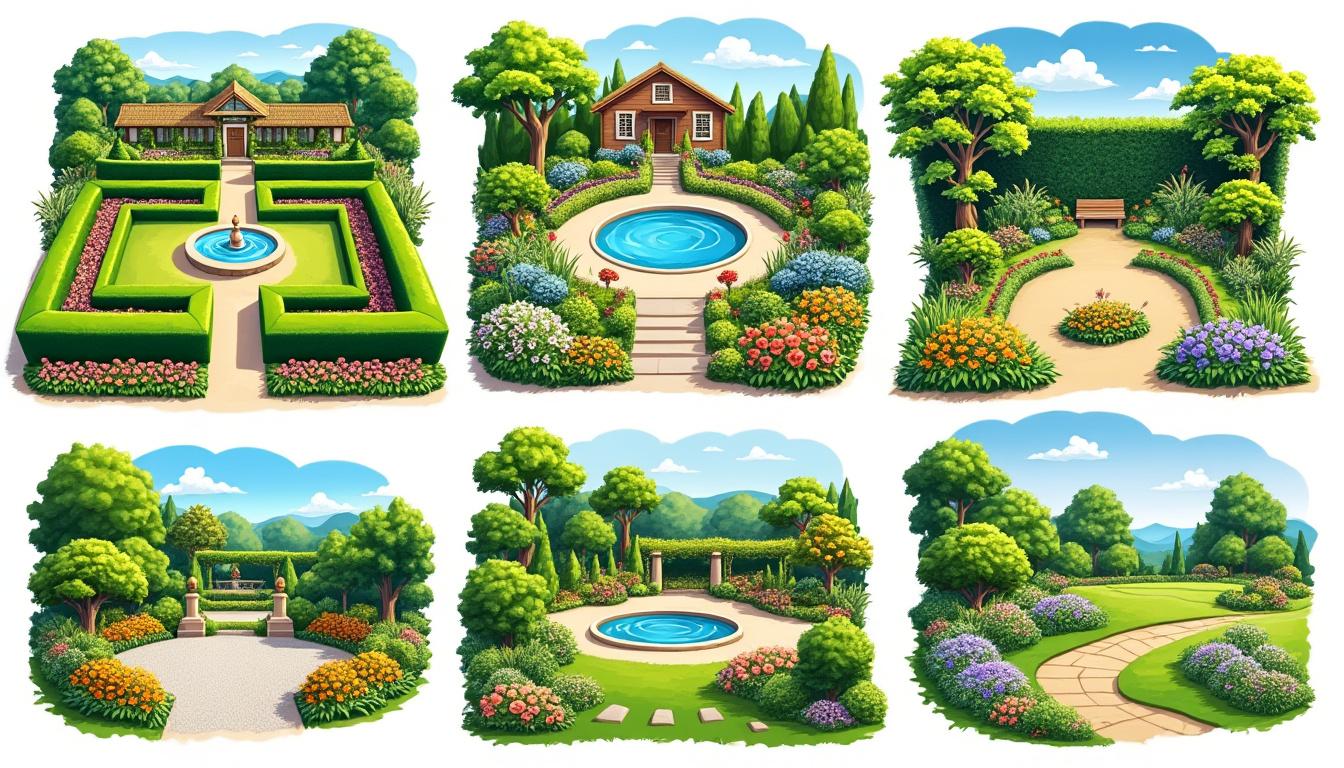The art of garden design has evolved through the centuries, yet some techniques remain eternally relevant and effective. Rooted deeply in tradition, these classical approaches offer timeless charm and functional elegance that never fade. In a world where trends often come and go, returning to these foundational styles provides gardeners and entrepreneurs alike with reliable methods to create stunning outdoor spaces. From the enduring principles of symmetry to the careful use of color and texture, understanding these six classic garden design techniques can transform any space into a sanctuary of beauty and comfort, embracing influences from industry leaders like Burpee, Proven Winners, and David Austin Roses.
Symmetry And Geometry: Foundations Of Timeless Garden Design
Symmetry and geometric structure form the cornerstone of classic garden design. This technique emphasizes balance and order, where elements are arranged to mirror each other across focal axes, creating a sense of harmony and calm. The crisp lines and formal shapes are often evident in traditional European garden styles, such as Renaissance and Baroque gardens, which inspire contemporary gardeners and professionals alike.
This method often includes pathways, hedges, and flowerbeds shaped into circles, squares, or rectangles. Boxwood hedges from companies like Monrovia are frequently used to outline these geometric patterns, providing structure and continuity throughout the garden. The use of symmetry also extends to architectural elements such as fountains, sculptures, and benches, which serve as central features in these layouts.
Symmetry is not only visually pleasing but also practical, guiding movement through the garden and enhancing spatial awareness. It cleverly draws the eye to key points, enhancing the experience of exploring outdoor spaces. A well-executed symmetrical design can complement any garden size, from compact urban courtyards to sprawling country estates.
- Key features of symmetry and geometry include:
- Mirrored plantings and garden structures
- Defined shapes like squares, rectangles, and circles
- Use of evergreen hedges for consistent form
- Integration with architectural elements
Garden Design Magazine highlights that incorporating symmetry is crucial for retaining timeless appeal, as it appeals to the human preference for balance and order. Businesses such as Gardener’s Supply Company offer tools and design plans specifically catered to help enthusiasts maintain these perfect lines and shapes.
| Element | Purpose | Recommended Plants or Materials |
|---|---|---|
| Boxwood Hedge | Defines pathways and garden beds | Monrovia Boxwood |
| Stone Pathways | Enhances geometric patterns | Natural slate or granite |
| Focal Fountain | Central visual point | Classic stone or bronze |
The Enduring Power Of Color Harmony In Garden Planning
Color is an essential tool for garden designers, wielded to influence mood, highlight features, and produce a dynamic visual narrative. Classic garden design leverages color harmony, thoughtfully combining hues to ensure longevity and appeal irrespective of passing fads.
A popular approach uses complementary colors — shades opposite each other on the color wheel such as soft purples and yellows. For instance, plants like lavender paired with yellow daylilies can create compelling borders that delight year after year. Proven Winners and Eden Brothers offer a wide range of plants chosen specifically for their vibrant and lasting colors, catering to classic palettes.
Furthermore, tonal harmony can be achieved by grouping plants with related colors, such as various shades of pink roses. David Austin Roses, favored for their strong colors and scent, excel in such arrangements. Gardeners are encouraged to consider leaf color and texture as well, which enrich gray days when flowers may be sparse.
Using color strategically in design includes:
- Creating seasonal interest with layered bloom times
- Balancing bold and neutral tones
- Selecting plants that complement architectural features
- Employing foliage colors for year-round appeal
Color harmony, unlike fleeting trends, remains a constant in guiding viewers’ emotions and enhancing garden charm. Resources such as Better Homes & Gardens regularly provide insights into color pairing that support enduring design success.
| Color Scheme | Example Plants | Ideal Usage |
|---|---|---|
| Complementary | Lavender, Yellow Daylily | Borders and flowerbeds |
| Monochromatic | Roses in varying pinks | Formal parterres |
| Analogous | Orange, Red, Yellow Marigolds | Vibrant beds |
Incorporating Mature Trees And Aged Materials For Timeless Appeal
Mature trees act as the backbone of a classic garden, providing shade, structure, and a sense of permanence. Unlike newly planted saplings, mature trees impart immediate character and scale to any landscape. Maintaining existing trees preserves natural heritage and minimizes environmental disruption.
Aged materials such as weathered stone, reclaimed wood, and antique railings evoke a sense of history that enhances the garden’s authenticity. Renowned brands like Fiskars supply quality pruning tools essential for the careful maintenance of such mature plantings to keep the garden pristine. Gardeners who embrace aged materials can craft inviting garden rooms that transport visitors through time.
Benefits of using mature features include:
- Instant garden maturity and scale
- Lower maintenance due to established root systems
- Historic ambiance blended with natural beauty
- Contrast with softer plantings to highlight textures
Permitting mature trees to remain is a critical consideration in garden design projects, often recommended in articles such as those found at Rustic Garden Concepts. This approach respects natural evolution while complementing design intent, ensuring the garden remains evergreen in its appeal.
| Material | Typical Use | Benefits |
|---|---|---|
| Reclaimed Wood | Benches, fences | Rustic charm and sustainability |
| Weathered Stone | Pathways, walls | Durability and historic appeal |
| Established Oak Tree | Shade and centerpiece | Immediate maturity and habitat |
Using Formal Borders And Structured Planting To Frame Outdoor Space
Formal borders and structured planting define garden limits while offering a decorative edge that enhances the overall design. This method involves layers of plants arranged in ordered tiers, frequently using evergreen shrubs such as boxwoods alongside perennial flowers to maintain color and form throughout the year.
Companies like Burpee and Scotts Miracle-Gro provide plant varieties and fertilizers that support the vigorous growth and health necessary to achieve dense, neat borders. Moreover, structured planting guides visitor movement gently and delineates functional zones in larger gardens.
Advantages of this technique include:
- Defined spatial boundaries that reduce garden clutter
- Year-round aesthetic through evergreen inclusion
- Easy management and maintenance schedules
- Enhanced wildlife habitat with layered plantings
Formal borders also integrate well with other classical methods such as symmetry and mature trees, creating a cohesive and inviting environment. For practical gardening advice, resources like Home Garden Outdoor Exploration offer extensive tips.
| Plant Type | Role | Recommended Brands |
|---|---|---|
| Boxwood | Evergreen structure | Monrovia |
| Lavender | Fragrance and bloom | Garden Design Magazine favorites |
| Peonies | Bold seasonal color | Eden Brothers |
The Classic Use Of Water Features To Enhance Garden Tranquility
Water features are a hallmark in many classic garden styles, offering dynamic visual interest and sound that fosters relaxation. From reflecting pools that mirror the sky and foliage to fountains that provide rhythmic background sound, incorporating water remains an elegant technique fundamental to timeless garden design.
Specialists recommend choosing water features that complement the garden’s scale and architecture. For example, a modest garden benefits from a small birdbath or bubbling urn rather than a large, ornate fountain. Brands like Fiskars supply garden tools that support installation and maintenance of these water elements efficiently.
Key benefits of water features:
- Introduce movement and sound for sensory enrichment
- Attract wildlife such as birds and butterflies
- Create reflective surfaces to visually expand space
- Cool the ambient air and add humidity in dry climates
Incorporating water thoughtfully can tie together other garden components, enhancing the serene atmosphere. Articles on Garden Inspirations Magical Landscapes illustrate how water influences balance and peace in outdoor design effectively.
| Water Feature Type | Ideal Placement | Size Suitability |
|---|---|---|
| Bubbling Fountain | Central focal point | Medium to large gardens |
| Reflecting Pool | Along main pathways | Large formal spaces |
| Birdbath | Near seating areas | Small urban gardens |
FAQ: Essential Questions About Classic Garden Design Techniques
- What plants are best for creating classic formal borders?
Evergreen shrubs like boxwood from Monrovia, lavender, and peonies from Eden Brothers provide structure and seasonal color essential for classic borders. - How do mature trees influence garden design?
Mature trees offer immediate scale, shade, and wildlife habitat, creating a permanent natural frame that enhances garden structure and beauty. - Which color combinations work best for timeless garden aesthetics?
Complementary colors, such as lavender with yellow daylilies, and monochromatic schemes with varied tones of pink roses from David Austin Roses are enduring choices. - What are easy ways to incorporate water features into small gardens?
Utilizing a small birdbath or bubbling urn creates peaceful sound and visual appeal without overwhelming compact spaces. - How can garden tools improve maintenance of classic designs?
Quality tools from Fiskars and other specialized companies help maintain clean lines, proper pruning, and healthy plant growth crucial for classic aesthetic upkeep.

